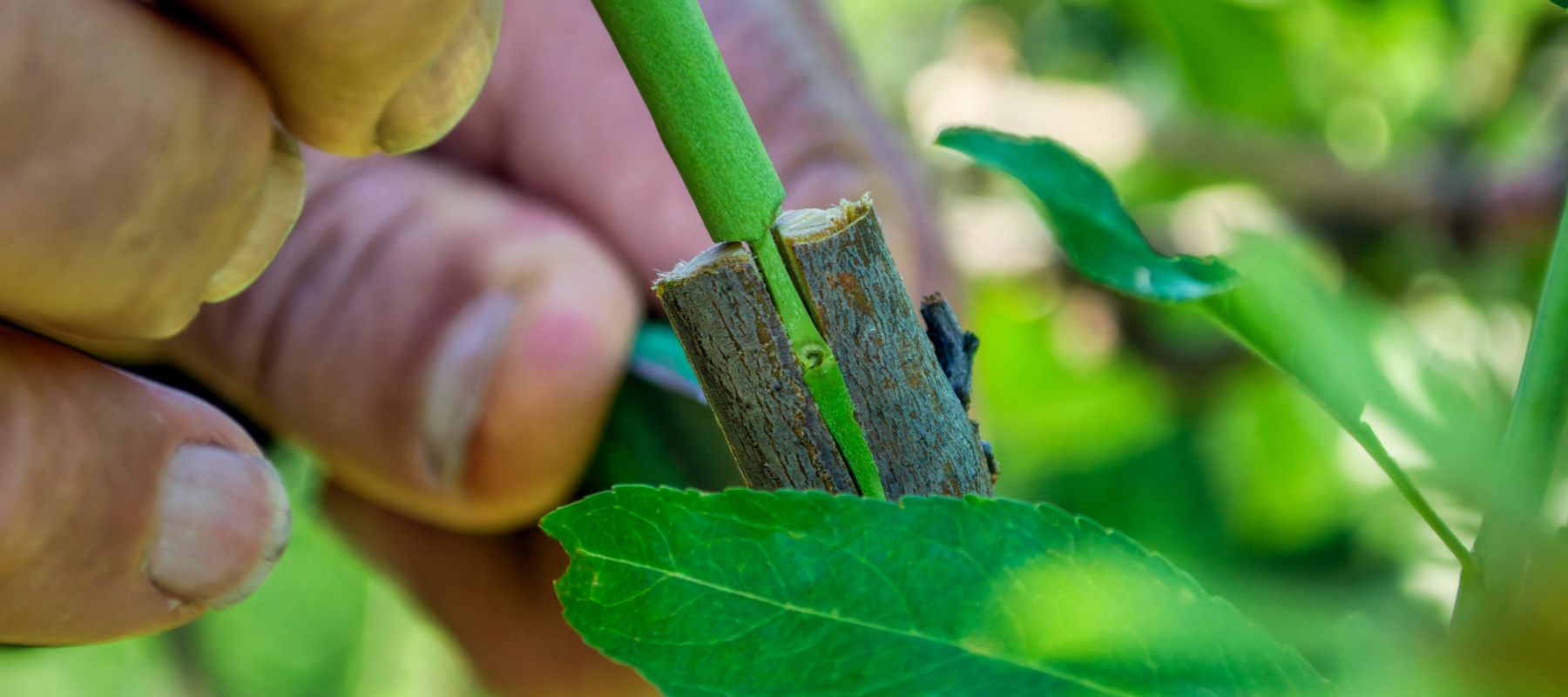Lesson 4 - Other methods of propagation

Some plants respond well to propagation using different methods; layering, division, budding and grafting. In this lesson we introduce a few methods but this is a whole big, beautiful area that we encourage you to explore.
There are other methods of propagation that use different techniques and are used on living plants to create a new plant. Simple layering of a berry for example. Take a long berry cane and look for a node on a berry cane and peg the cane down into the soil with a peg on either side of the node. Cover the node with soil and water. Once the node is in contact with the soil it is stimulated to produce roots. Check for root growth after a few weeks. Once these roots have developed, the new plant can then be cut from the mother plant and moved to a new bed. You often see wild blackberries forming new plants at the point at which a cane has grown long enough to reach the ground.
Aerial layering is a vegetative propagation technique where plants are encouraged to produce roots while still being attached to the parent plant. It is a bit of a fiddly process and tends to be a bit more complicated and is used on species that are hard to propagate.
Division of plants is an easy and economical way of increasing your plant numbers. Choose plants with running or clumping root structures, as they are easy to divide. For example, plants in the mint family are very easy to divide as are chives and thyme. As mint is so vigorous, we recommend that you plant mint in pots rather than in the ground as they can become invasive. Divide clumping plants by digging up the entire clump and gently teasing the plant apart ensuring you choose sections with good root development. You may find that you can divide one clump of chives into five separate plants.
Some vegetables are part of the perennial plant group known as geophytes. Geo means “earth” and phyte meaning “plant”. These are plants which have adapted to survive harsh environmental conditions and grazing animals. The main feature is a storage structure or organ that lives underground and stores both water and nutrients. When conditions are right the storage structure which is also known as a bulb, tuber, corm or rhizome grows and flowers. Examples of edible geophytes are potatoes, Jerusalem artichokes and taro. Division of geophytes is best when the plants are dormant, after they have died back. Gently dig them up and divide the tubers up, plant them individually, spaced apart for the next season. Make sure you mark where they are as they will lie dormant for some months in the soil until the next growing season and it is very easy to forget where they are.
Budding is a method of inserting a single bud of one variety into the wood of another in order to join a desirable variety onto an existing tree or rootstock. To be sucessful both varieties must be compatible with each other and of the same species. It is essential that the cambial wood of both the donor bud and the recipient tree are in contact with each other for them to callus and form a union.
Most deciduous trees can be budded in late summer with both the bud and the recipient wood best chosen from vigorous current season growth. The procedure must be done quickly so the freshly cut wood does not have a chance to dry out.
The simplest method of budding is to cut a small T in the wood of the recipient tree. Using a sharp grafting knife the bark is loosened either side of the cut allowing the insertion of the donor bud, with some cambium attached. The bud is then secured and the wound wrapped tightly with grafting tape.
Like budding, grafting is a method of joining one variety of tree to another within the same species. It is often used for fruit trees to graft the desired variety onto a suitable rootstock but can be used to graft different varieties onto the same tree.
A piece of dormant wood (called a scion) is cut from the donor tree and attached to a similar diameter branch of the rootstock or recipient tree. The scion wood should be 20 – 40cms long and contain several buds.
Grafting is best just before bud burst in late winter or early spring when sap is beginning to move in the wood. One year old wood is ideal for both the scion and the site of the graft.
The aim is to join the two pieces so that maximum contact is made between the two cut surfaces. There are many different approaches to grafting, the easiest being to cut both pieces at a sharp angle and match them up. A ‘V’ shaped cut is also often used with the scion wood cut at a corresponding angle so that it can slot into the V which has been cut on the rootstock. The graft should then be wrapped with grafting tape until it has taken.
Mound layering
For some plants propagation by cutting is difficult or impossible. One solution is to encourage rooted cutting material by mound layering. The mother plant is cut low to the ground and a mound or box filled with potting soil is placed over it. New shoots and regrowth from the cut grow through the mound and form roots while still attached to the mother plant. Propagation material can then be obtained by separating rooted cuttings from the mother plant using secateurs or a sharp knife.
Further learning
Propagation: the aerial layering technique – Gardening Australia
Propagating herbs – Gardening Australia